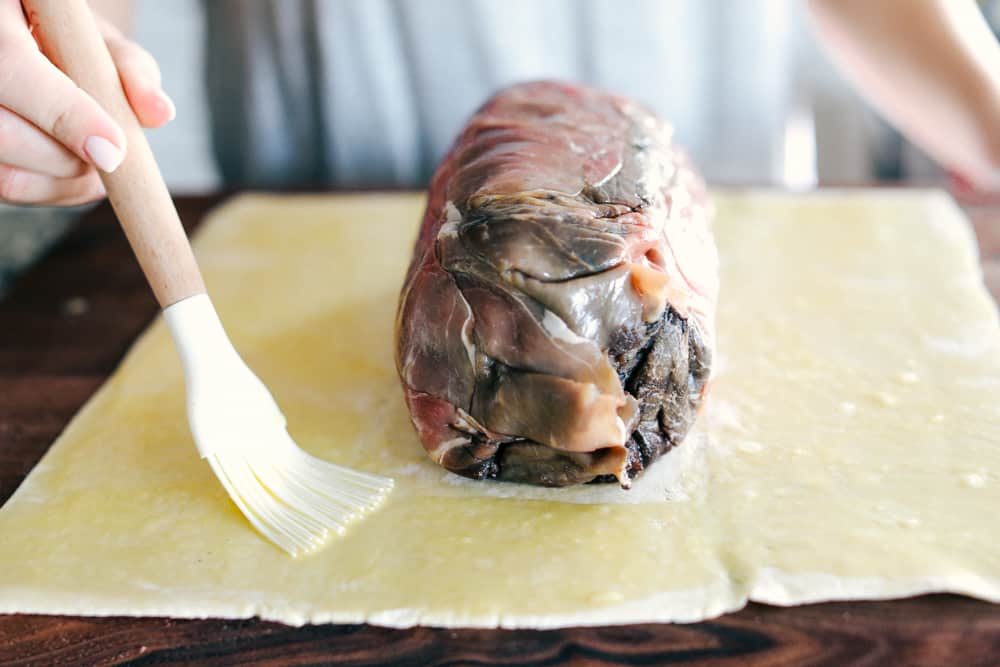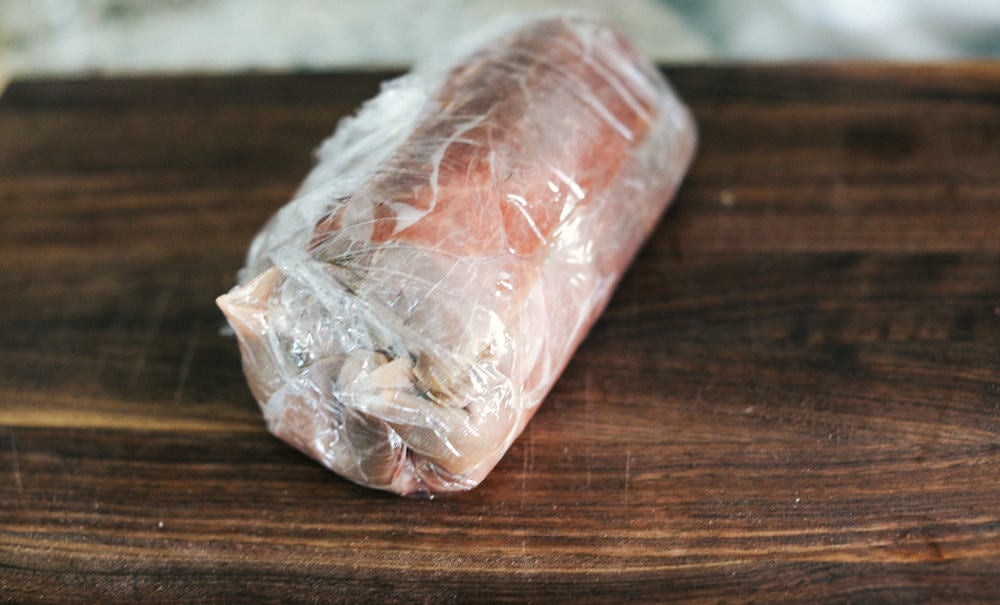Beef Wellington is a rich, juicy, and tender beef tenderloin wrapped in a soft, buttery pastry and baked until golden brown. It has a layer of mustard, mushroom duxelles, and prosciutto on top. A holiday favorite!.
Impress your family with this rich, decadent meal for the holidays. If you want to make a really special meal, try this Garlic Butter Herb Prime Rib Recipe or this Garlic Butter Herb Beef Tenderloin Recipe.
Beef wellington is a classic dish that has been popular for centuries It consists of a beef tenderloin that is wrapped in layers of mushroom duxelle, prosciutto ham, and puff pastry before being baked. While delicious, it’s also a dish that can be tricky to get just right One of the most important factors in creating a perfect beef wellington is choosing the right cut of beef. Let’s take a closer look at exactly what cut of beef you should use for beef wellington.
What is Beef Wellington?
First, let’s make sure we’re all on the same page about what beef wellington is. As mentioned, it’s a layered dish consisting of beef, mushrooms, ham, and pastry. Specifically:
-
A tender cut of beef is seasoned and seared. Tenderloin is most traditional, but some recipes call for filet mignon instead.
-
Duxelle is a finely chopped mushroom mixture that is sautéed with shallots and herbs. It acts as a layer around the beef, adding moisture and flavor.
-
Prosciutto ham (usually Parma ham) wraps around the duxelles, sealing in the moisture
-
Puff pastry envelops everything, creating a golden crust when baked.
-
Sometimes pâté or liver spread is used as an additional layer, but the duxelles and ham are always included.
When done properly the result is tender beef infused with umami mushroom flavor and encased in a flaky buttery puff pastry. It’s a impressive yet comforting dish that just about anyone can learn to master with the right ingredients.
Why the Cut of Beef Matters
Tougher cuts of beef often require slow braising to become tender. Because beef wellington uses a faster cooking method, the natural tenderness of the raw beef is important. No one wants sliced beef wellington to reveal a chewy, tough center!
The strip loin or tenderloin are the cuts of choice for beef wellington since they are naturally tender. In particular, the tenderloin is prized for its melt-in-your-mouth texture. Filet mignon, cut from the smaller end of the tenderloin, is an especially popular choice.
Lean tenderloin also lends itself well to complementing flavors like duxelle and prosciutto. Fattier cuts would compete with rather than enhance the other flavors.
Filet Mignon vs. Tenderloin
Both filet mignon and whole tenderloin are great options for beef wellington. Here’s how they compare:
Filet Mignon
-
Cut from the narrower top end of the tenderloin.
-
More uniform in shape for even cooking.
-
Usually more expensive per pound.
-
Portioned for individual servings or appetites.
-
Easier to sear thoroughly on all sides.
Tenderloin
-
The full tenderloin muscle.
-
Thicker and more irregularly shaped.
-
Must be trimmed of sinew and chain muscle.
-
Lower cost per pound.
-
Can serve a crowd by slicing cooked wellington.
-
May require tying to promote even cooking.
Either option can produce excellent beef wellington. For a dinner party, a whole tenderloin may make the most economic sense. But for individual Wellingtons, filet mignon may be easier to manage.
The Best Thickness for Beef Wellington
Aim for a finished thickness around 2 to 3 inches when choosing your beef. Thinner cuts risk overcooking. Much thicker, and it’s hard to properly sear and bake the beef through.
For filet mignon, look for pieces:
-
1.5 to 2 inches thick for small or individual beef wellington.
-
2 to 2.5 inches for larger roulade-style wellington.
For a whole tenderloin, choose one:
-
2 to 3 pounds in weight.
-
4 to 5 inches in diameter at the thickest end.
-
Tied to promote even thickness, if needed.
This should allow enough thickness to give you a nice red center when sliced, without any undercooked meat. Check that the center reaches 130-135°F for medium rare doneness after resting.
Preparing the Beef for Best Results
Once you’ve got the right cut, proper preparation is also key:
-
Trim any excess fat and silverskin for better presentation. Leave just a thin layer of fat for flavor.
-
Season generously with salt and pepper before searing. A marinade, spice rub, or herb crust can also be used.
-
Sear the beef well to develop a nice crust. Use high heat and browned butter or oil.
-
Allow beef to cool slightly before wrapping in duxelle and pastry.
-
Chill wrapped wellington for at least 30 minutes before baking if possible.
Other Cuts to Consider
While tenderloin is traditional, other cuts can also work well. Ribeye, strip steak, or sirloin can all be prepared similarly:
-
Choose a thicker, boneless cut.
-
Trim excess fat and pound to tenderize.
-
Briskly sear all sides before wrapping in duxelle and pastry.
The cooking time may need to be adjusted compared to tenderloin. And the beef will likely be a bit chewier even when cooked to medium doneness. But with proper preparation, these cuts can still make a tasty beef wellington.
To sum up, for a classic beef wellington with tender, rosy meat, tenderloin is hard to beat. Look for a center cut filet mignon or trimmed whole tenderloin about 2 to 3 inches thick. Properly season, sear, and cool the beef before wrapping and baking. With the right prep, you can enjoy perfect beef wellington.
Following this guide for choosing the ideal cut of beef, along with great supporting ingredients like duxelle and puff pastry, will help you succeed with this impressive dish. Just resist the urge to peek while it’s baking for beef wellington that cuts like a dream. Enjoy this iconic meal that brings together flavorful fillings and crisp, flaky pastry with melt-in-your mouth beef.

How to Make Beef Wellington
I can’t wait for you to try Beef Wellington! It has layers of sweet and savory flavors that melt in your mouth and taste so good!
- Sear the Tenderloin: Generously salt and pepper your tenderloin. Put the olive oil in a large skillet and set it over medium-high heat. It should be seared for about two to three minutes on each side until it gets a golden brown crust. Remove from the heat and set aside.
- For the Mushroom Duxelles, put the mushrooms, garlic, and onion in a food processor and pulse them until smooth. Then, pulse it in the food processor until it turns into a smooth paste. Heat your skillet to medium high and add the mixture. Sauté the mushrooms until you have the moisture has left. Remove from heat and let cool.
- The tenderloin needs to be wrapped. Lay out some plastic wrap and lay the prosciutto on it so that it is even and overlaps. Cover the top with the mushroom mixture, leaving an inch of space on all sides. Spread mustard on the tenderloin, and then wrap it in the prosciutto and mushroom mixture. As you roll it up, fold the sides up around it. Put the beef in the fridge for 30 minutes with the plastic wrap tightly around it.
- Add Puf Pastry: Preheat oven to 400 degrees Fahrenheit. Put some flour on a surface and roll out the puff pastry sheet. Place the tenderloin in the center. Then, brush the egg mixture all around the tenderloin on the baking sheet and roll it up tight in the pastry. Brush the rest of the egg mixture on the outside of the dough and make holes in the top.
- Put it in the oven and bake it until the crust is golden and the beef reaches 120 degrees for medium rare. About 45 minutes. Take it out of the oven and let it cool for 10 minutes before cutting it.

Ingredients in Beef Wellington
The cut of meat is the most important! You definitely want to splurge on some tender meat. Check out the recipe card at the bottom of the post for exact measurements.
- Beef Tenderloin: The name says it all—beef tenderloin is a tender cut of beef that is perfect for this recipe.
- Salt and pepper: These will make the meat taste better.
- Olive oil: This helps the tenderloin brown before you wrap it up.
- Mushrooms: I used Bella mushrooms for this mixture.
- Onion: The onion adds a delightful taste to the mushrooms.
- Garlic: You can use fresh garlic cloves or garlic that has been minced from a jar. 1/2 teaspoon equals about one clove of garlic.
- Prosciutto: You put this extra layer of meat around the duxelles mushrooms.
- Yellow Mustard: You can use any kind of yellow mustard you like. This is the sauce for the beef Wellington.
- This is what holds it all together before you bake it.
- Eggs: The eggs give the pastry a golden brown color.

Beef Wellington: Learn about the cut of this meat! SALTOPIA
FAQ
What is the best cut of meat for Beef Wellington?
What can I use for Beef Wellington instead of tenderloin?
Which cut from the beef carcass is used for a Beef Wellington?
What is a good substitute for beef tenderloin?
What can I use to make a Beef Wellington?
Garlic: You can use either fresh or jarred minced garlic. ½ teaspoon equals about one clove of garlic. Prosciutto: You encircle the mushroom duxelles with this extra layer of meat. Yellow Mustard: The yellow mustard will serve as a glaze for the beef wellington, so feel free to use any variety you like.
What kind of meat is used in Beef Wellington?
The meat used in beef Wellington, which is typically a fillet steak, beef tenderloin, or filet mignon, is a nice cut. It makes use of the center-cut, which is thought to be the most tender and juicy part of the cow. The meat is encased in a mustard sauce, followed by prosciutto and mushroom duxelles.
How can I make Beef Wellington taste better?
Using the best quality ingredients can help improve the taste of Beef Wellington. Getting frozen all-butter puff pastry for the outer layer and using a layer of prosciutto adds flavor and acts as a barrier to prevent the mushroom paste from making the pastry soggy.
Can you make Beef Wellington at home?
You don’t have to go to a restaurant to have really good Beef Wellington. Making it at home is possible with a crisp puff pastry shell encasing mushroom paste and prosciutto and a perfectly pink beef tenderloin center. It’s a multi-step process, but it’s not as hard as you’d think.
